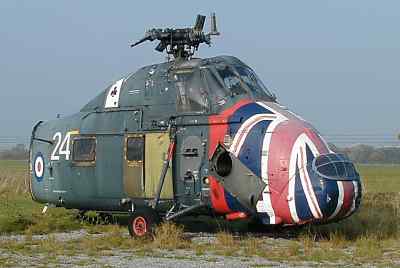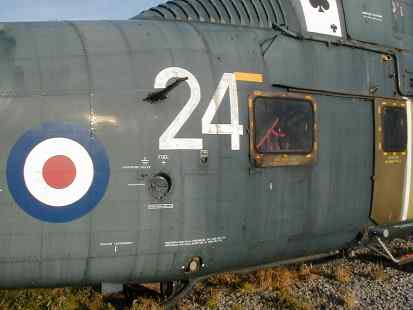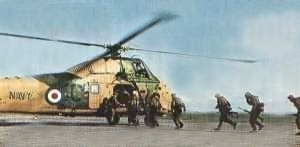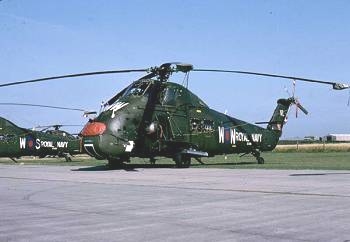Westland Wessex HU.5 XS486
In March 2004 The Helicopter Museum took delivery of the front fuselage, with rotorhead and cabin, of Westland Wessex HU.5, XS486, c/n WA160. It was built at Yeovil and delivered to the Royal Navy, in March 1964, as one of the first production machines, intended as a standard, ship borne, Commando assault helicopter. Powered by two coupled 1250 shp Bristol-Siddeley (Rolls-Royce) Gnome Mk.110 turboshafts the HU.5 had greater lift capability, reliability and strength than earlier marks. |

|
|
| The XS486 fuselage section has a complete cabin interior which, in spite of long exposure to the weather, appears to be in good condition. The rotorhead and gearbox are in place, though the main blades have been sawn off. The rear section of the fuselage and the tail are missing but can be replaced from a donor machine. Many of the cockpit instruments have been removed but the Museum holds suitable spares. Similarly the machine has no engines but the Museum has two Gnome turboshafts, similar to the originals, which will be suitable for installation to allow eventual static display. |  |
 |
Initially, XS486 was stationed at RNAS Culdrose with 707 Squadron, providing the Commando Helicopter Operational Training Course, with a brief detachment to 846 Squadron. XS486 was moved to RNAS Yeovilton, with 707 Squadron, in 1972, and was often seen at the annual International Air Days at Yeovilton in the seventies, taking part in the impressive "Mass Flypast" which opened the display. | |
| Wessex HU.5, XS483, loading troops in 1965 | ||
|
|
||
 |
On 19th April 1982 XS486 was transferred, from RNAS Yeovilton's 707 Squadron, to 'A' flight of a hastily reformed 848 Squadron and had toned down wartime markings applied, with the original serials and codes overpainted black. On the same day it embarked on RFA 'Regent' from Portland, sailing, via Devonport and Ascension, for the South Atlantic and the Falklands conflict. On arrival in the Falklands area, on 12th May, 'Regent' joined the aircraft carriers 'Hermes' and 'Invincible'. The Squadron's HU.5s were used for replenishment, troop transport and casualty evacuation throughout the Carrier Battle Group. XS486 and XT765, the two Wessex HU.5s assigned to 'Regent,' transferred a total of 2562 pallets of stores and ammunition in support of the Task Force. Photo (left) by John Hale. | |
 |
After the main Argentine force surrendered on 14th June, XS486 was transferred to 'Endurance', managing to share the hangar with two Wasps, to ferry marines for the recapture of South Thule. Then, after two weeks back with 'Regent' off Port Stanley, on delivery and replenishment duties, XS486 returned to the UK on the container ship 'Atlantic Causeway', reaching Devonport on 27th July 1982. It was transferred directly to 707 Squadron at Yeovilton and placed in the care of the Naval Air Support Unit (NASU) for cleaning, inspection and treatment for magnesium alloy corrosion. A total of forty-six Wessex HU.5s had been sent to the South Atlantic though six, assigned to 'D' Flight of 848 Squadron, were lost in the sinking of 'Atlantic Conveyor'. | |
| XS486 above 'Endurance' in June 1982 | ||
|
XS486 remained at Yeovilton, with the exception of short visits to RNAS Culdrose, until 1986. It went into storage at Wroughton in 1987, remaining there until 1990 when it joined the Royal Navy's recruiting team at Lee-on-Solent, returning to Wroughton in 1995. In 2000 XS486 passed into the hands of No.93 Squadron of the Air Training Corps, in Bath. Subsequently it became semi-derelict, at nearby Colerne airfield, until spotted by Friends member John Phillips, in 2003. As a result it was offered to The Helicopter Museum in exchange for one of the Museum's Whirlwinds. This Whirlwind, retrieved from storage, was despatched to Colerne on 12th May 2004. |
||
| XS486 awaits restoration and is not, currently, on public display at The Museum. | ||